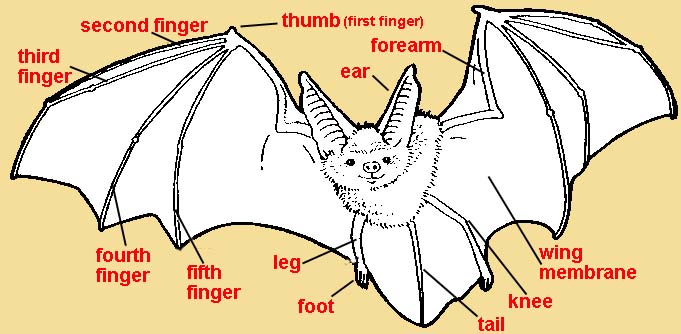
Bat illustration by Aletha Reppel, Bat Conservation International Educator's Activity Book
A BAT'S BODY DOES MANY THINGS THAT HELP IT LIVE.
EARS: Bats have very good hearing. They use it for finding food and
locating their babies. For insect and fish eaters, the big ears help with
echolocation. Usually, echoes are received by funnel-shaped ears that face forward.
NOSE: The sense of smell is well developed in most bats. It is used to find and identify certain foods and to recognize roost mates and young. Fruit eating bats can find their food by the smell of the ripening fruit.
Nectar seeking bats gather pollen on their snout, and by going from flower to flower help create new plants.
EYES: Bats are not blind! For example, flying fox bats have very good
eyesight and they use their eyes along with their excellent sense of smell to help find food in the dark. Bats' eyes are better at seeting in the dark.
Most see objects only in black and white, but color vision is known to exist in someold world fruit bats.
FEET: With their strong claws, bats are able to hang upside down in their
roosts. Fishing bats also use their claws to scoop up the fish they will eat.
HANDS AND WINGS: Bats fly by using their hands and wings. While
the wings are flapping, bats can go up or down by moving the membrane
between the body and fifth finger. This is called "lift." Bats move forward (called "thrust") by changing the shape of the membrane between the second and fifth fingers.
FUR ON THEIR BODY: You can tell that a bat is a mammal
because it has fur or hair on its body. The fur protects the bat because
different colors and designs can serve as camouflage and they can hide from danger. The fur is kept clean by regular licking, somewhat like what a cat does. In the winter it helps keep the bat warm.